If you love the charming, rustic feel of farmhouse style but your exterior is looking a bit tired, a fresh coat of paint may be just what you need. The right exterior color scheme can update the look of your home while highlighting its best architectural features. When planning a farmhouse-inspired palette, you have plenty of options. From crisp whites to earthy neutrals, bold brights to serene blues, there are countless ways to give your home’s exterior a face lift. Read on for ideas to inspire your next exterior refresh.
When embarking on an exterior re-paint, there are a few key factors to consider. Look at the architectural details of your home to determine which colors will complement the existing style and features. Also examine your landscaping to see if certain hues in the greenery or hardscaping can guide your palette. And don’t forget to look to other farmhouses in your area to gauge whether you want your home to blend in or stand out.
Classic Farmhouse Color Combinations
Some tried-and-true exterior color schemes never go out of style. Here are a few timeless options steeped in farmhouse tradition:
- Bright white siding with black window shutters creates a crisp, classic contrast.
- Light gray walls with white trim and pops of cherry red on the front door and window boxes exude old-world charm.
- A tan or beige exterior accented by forest green shutters evokes a warm, earthy vibe.
- Soft blue-gray siding paired with bright white trim and door lends a serene, coastal feel.
- An all-white exterior with natural cedar shake siding and trim embraces farmhouse simplicity.
These tried-and-truecombinations demonstrate why certain exterior colors stand the test of time. They highlight the farmhouse’s architecture while looking fresh and inviting.
Modern Farmhouse Exterior Colors
While classic color schemes still reign supreme, today’s farmhouse style also embraces bold, modern hues. Here are some trending ideas for exterior palettes:

Vibrant siding colors like coral, sunshine yellow, or navy blue make a bold statement. Black or charcoal gray siding allows colors like cherry red, turquoise, and violet to pop even more on accent elements like the front door.
For more subtlety, try light blue-gray or sage green siding with crisp white trim. Or, opt for a borderless white exterior to let your colorful landscaping take center stage.
Mixing complementary neutrals is another great way to strike a modern-yet-classic balance. Think warm browns and taupes paired with cool slates and grays.
Choosing Colors to Complement Architecture
Every farmhouse has unique architectural details that exterior colors can highlight. Here are some tips for choosing a color scheme tailored to your home’s shape and style:
- Select a color palette that complements your home’s existing architectural style. Cool grays suit East Coast Colonials while warmer earth tones complement Craftsman bungalows.
- If your home features special structural elements like stone accents, a wraparound porch or dormer windows, choose colors that accentuate these details.
- Consider existing exterior materials. If your home mixes brick, wood, and stone, pick colors that tie the elements together into a cohesive whole.
- Coordiante your siding, trim, shutters, door, and other accent colors for a pulled-together look. Contrasting hues help each architectural detail stand out.
With some thoughtful color placement, you can highlight the charming architectural details that give your farmhouse its character.
Selecting an Exterior Color Scheme for Your Landscape
Surrounding trees, gardens, and landscaping should also inform your exterior color selection. Here are some landscape-inspired ideas:
Choose colors pulled from the natural foliage surrounding your home. Sage green, terra cotta, and warm, organic neutrals complement leafy green exteriors. Let the lushness be your guide.
Pick out a striking hue from your garden flowers or groundcover plants and repeat it on the exterior. Vivid accent colors connect your home to its beautiful surroundings.
Use color to highlight or contrast with your landscaping. Contrasting blue-grays against autumn foliage or evergreens makes both pop.
Factor in sunlight and shade when planning your palette. Cool tones may suit shaded northern exposures while southern exposures bathed in sun can handle warmer shades.
Accent Colors to Make Your Farmhouse Pop
Strategic accent colors add visual interest to farmhouse exteriors. Try these easy, eye-catching touches:
- Bright white trim provides crisp contrast against colorful siding, making both colors “pop.”
- A vibrant red, navy, black, or teal front door serves as a striking focal point.
- Contrasting shutter colors, like black against white siding, add appealing texture and dimension.
- Cheery flower boxes in hues pulled from your landscaping tie it all together.
With thoughtful placement of accent colors, you can highlight your home’s architecture, link to the landscape, and give your farmhouse extra curb appeal.
Paint Sheens for Exterior Surfaces
Choosing the right paint sheen is key for long-lasting exterior color. Here are some finishes perfect for farmhouse exteriors:
- Flat or matte finishes work best for siding as they disguise surface imperfections.
- Semi-gloss paint on trim, doors, shutters, and accent details resists dirt and is easy to clean.
- Satin finishes offer subtle sheen on siding while providing protection and longevity.
- Glossy finishes stand up to weather on metal railings, gutters, and other structural elements.
Consult with paint experts to select the ideal sheen for your exterior surfaces. The right finish protects your siding while making cleaning a breeze.
Your home’s exterior color scheme makes an impression. Infusing your farmhouse with updated hues enhances curb appeal while breathing new life into time-worn architecture. So explore the possibilities – from crisp whites, to warm and cool neutrals, to vibrant brights – until you discover your perfect palette. With a fresh coat of paint and strategic color placement, you can refresh your farmhouse exterior and highlight its inherent rustic charm.
